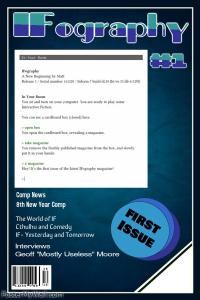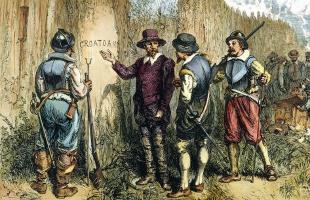Copy Link
Add to Bookmark
Report
The CyberSenior Review Volume 3 Number 2

start cybersenior.3.2
====================================================
************
* THE
* CYBERSENIOR
* REVIEW
************
===================================================
VOLUME 3 NUMBER 2 APRIL 1996
===================================================
The CyberSenior Review is a project of the Internet
Elders List, an active world-wide Internet Mailing
List for seniors. The Review is written, edited and
published by members of the Elders for interested
netizens worldwide. Contributions from non-Elders
are welcome. Please query one of the editors first.
Contents copyrighted 1996 by the Internet Elders
List and by the authors. All rights reserved by the
authors. Quoting is permitted with attribution.
The editorial board of The CyberSenior Review:
Elaine Dabbs edabbs@syd.dwt.csiro.au
Pat Davidson patd@chatback.demon.co.uk
James Hursey jwhursey@cd.columbus.oh.us
=================================================================
CONTENTS, Volume 3, Number 2, April 1996
EDITORIAL by Elaine Dabbs
SNAKE OIL, SUGAR PILLS, AND RATS by Eloise Blanpied
Eloise looks at recent research that discloses the close
relationship between mind and body.
WEDDING BELLS IN AMISH COUNTRY by Bill Powrie
Bill returns with another in his series on the quiet, gentle
folk of Amish country with a description of an Amish wedding.
SINISTER GOINGS-ON! by Pat Davidson
Are you adroit and dextrous? Or sinister and gauche? Pat
explores the mirror-image world of the lefthander.
THE AGED MAN, a poem by Jim Hursey
Who is that old guy anyway?
==============================================================
EDITORIAL
by Elaine Dabbs
With the seeming breakdown of community and family values in our
societies almost worldwide these days, it's refreshing to read in
Eloise's article that we don't need to suffer deep stress. No,
if we recognise that we can ease our burden and enjoy the luxury
of a calmness of spirit in the knowledge that the body can heal
itself, we will notice a remarkable change in our health. The
power of the mind can affect the body processes -- so, believe
this and there can be a new way of life. Read Eloise's article
about snake oil, sugar pills and rats -- you may even lose
weight!
We welcome another article by Bill about the gentle, quiet Amish
people and the customs followed when a wedding is announced.
Perhaps it's the very strict following of these old customs
which gives a sense of security and confidence to these folk who
don't appear to suffer the violence affecting so many parts of
the world these days. Bill tells us that marriage is a very
special occasion for the Amish -- does this follow in our own
societies?
Being a left-hander myself, I found myself nodding when I read
Pat's article about the almost notoriety given to left-handers
in days gone by. There was a claim that to be left-handed was
unnatural; we weren't even allowed the luxury of following our
natural inclination but had to go through the torture -- yes, it
was torture -- of using our right hand when, as five year olds,
we started school. I well remember those early days. However,
it's very handy being able to use either right or left hand when
painting the house so I just shake with silent laughter when I
watch a right-hander trying to paint in an awkward corner.
JimH says in his poem, "The Aged Man" that "wasted tears are
those for youth." How true. Do we want to be young again with
the accompanying anguish? Surely not. We can well afford to
enjoy our senior years by accepting ourselves as we are and
relax while we read our latest CyberSenior Review.
====================================================================
SNAKE OIL, SUGAR PILLS, AND RATS
by Eloise Blanpied
There's an argument going on between two factions concerned with
health and healing, but neither faction seems to have the crucial
issue in focus. On one side are the groups of healers who offer
predominantly anecdotal evidence that their potions or practices
(herbs, oils, touch) can cure illnesses ranging from the common cold
to cancer; on the other side are the traditionally-trained physicians
who reject all such "nonsense" in favor of AMA-approved medical
practices. Each faction is convinced that its own materials and
methods are curative and that the other's are either worthless or
dangerously harmful.
Overlooked by each is one of the most important concepts in the health
field; that is, potions or practices do not cure or heal. One's own
body heals itself, most often on its own (colds, flus, minor cuts,
bruises, strains), but sometimes needing an assist from outside
(fractures, appendicitis, major injuries or ailments). No
intervention -- neither herbs nor drugs nor surgery -- will contribute
to a cure if the body's natural healing process is not working. This
essential process is extremely complex and not yet fully understood
but is currently being rigorously investigated.
Our cultural history is filled with humorous or sad tales of travelling
medicine shows complete with charlatans and snake oil remedies.
Defining the consumers of these remedies as gullible victims has
deflected attention from the more important fact that the bizarre
concoctions being sold often did seem to work. A more modern
rendition of the same phenomenon substitutes sugar pills for snake
oil, and the positive response to the pills was smilingly discounted
as "just the placebo effect," reducing the event to a bit of
foolishness on the part of the patient. Yet when both of these events
are considered more objectively, profoundness, not foolishness, is
obvious. The positive response to snake oil remedies and sugar pills
demonstrates the power of the mind to affect the body processes. It
would seem that in each of the above cases it was the individual's
_belief_ in the curative power of the substance that resulted in the
cure or relief of symptoms.
But then there are rats. In this case, the rats were part of a
taste-aversion experiment conducted at the University of Rochester.
In order to determine the lasting power of induced taste aversion, an
injection of a drug which causes nausea was initially administered to
the rats jointly with their ingestion of saccharin-flavored water.
Thereafter, only saccharin-flavored water was administered, but it was
found that an aversion to the saccharin taste had already developed.
It persisted for 50 days. The rats had "learned" to associate
saccharin with nausea. Yet there's more to the story. Toward the end
of the experiment, the rats began dying. Further investigation of the
nausea-producing drug revealed that it also contained a property that
suppresses the immune system. Subsequent experiments confirmed the
following: Although the drug is administered once, the association of
it with the flavor of saccharin produces not only a persistent taste
aversion, but also a persistent suppression of the rats' immune
defense against illness. Obviously. belief is not the controlling
element in these studies as one would be hard-pressed to attribute a
belief system to a rat. But clearly, some action of the rat's brain
was involved with the functioning of the immune system.
In all three examples -- snake oil, sugar pills, and rats -- the
mind/brain influences physical health, and, as the examples
illustrate, the mind/body connection can produce either a positive or
negative response; it can strengthen or weaken the body's healing
process. How and why this happens is the decade's challenge for the
psychoneurological sciences, and the challenge for the rest of us is
to make sense of the many and varied findings that appear almost daily
in the press.
For example, we've all heard of the connection between Type A
Personality (aggressive, competitive) and heart disease but, on the
basis of media reports, few of us can describe the fine points of the
research that led to the theory, or the details of the personality
type, or the actual connection with heart disease. Few of us realize
that some subsequent research failed to find a connection between Type
A behavior and heart disease; that one group of researchers identified
hostility as the key behavior in heart disease patients; that others
identified stress and insecurity; that none of the research
consistently showed a connection between their selected behavior and
heart disease. Some studies even showed that Type B individuals
(unassertive, noncompetitive) were at greater risk for heart disease
than Type A individuals.
It is clear that along with genetic, environmental, and dietary
factors, behavior is somehow connected to heart disease, but it is
also clear that more than _observed_ behavior is involved. The
various and sometimes conflicting results in heart disease research
suggests that the link is the intention behind the behavior. Thus,
all else being equal, two individuals may be fiercely competitive but
may be at very different levels of risk for heart disease: one may be
a happy competitor treating the competition as a game; the other may
be a stressed competitor whose self-esteem is involved with the
outcome of the competition. These fine distinctions are often
ignored by the popularized theories about behavior and health.
We have all felt the impact of emotions on our physical state and, if
we've not experienced it ourselves, we've heard stories of how -- in
some individuals -- grief seems to trigger illness. We have noticed
that, while some persons manage to keep illness at bay until a
significant event or obligation has been accomplished, others succumb
in anticipation of the event. These are common examples of how the
mind/body connection influences us daily. But the influences are
unintentional; they happen to us; we do not consciously bring them
about.
Currently, research is being done on attempts to use the mind
intentionally to change certain processes of the body, to activate a
sluggish immune system, to lower blood pressure, to calm an irregular
heart beat, to soothe gastrointestinal turmoil, to alleviate skin
problems. This work raises the potential for a radically different
approach to health, an approach that emphasizes mental health and
mental activism as a way of life (literally).
The extraordinary importance of the relationship between our physical
well-being and how we handle life's joys and sorrows and the potential
for using our minds directly to preserve and enhance our physical
health makes arguments about potions and practices seem very much off
the mark.
====================================================================
WEDDING BELLS IN AMISH COUNTRY
by Bill Powrie
An Amish wedding is surrounded by much preparation and custom. I will
attempt to lead you through what is a typical wedding in the Lancaster
County Amish country.
First thing on the agenda for the perspective groom is the Testimonial
Letter. This is a request to marry a certain woman. It is obtained
usually at the fall communion after the October 11th fast day. The
request is given in writing to the Bishop and two Ministers of that
church for signature (usually in Old German script.) The signatures
signify that the groom is a member in good standing of the district
church.
The letter is then taken by the groom to a Deacon of the bride's
district church (if it is a different district). The Deacon then agrees
to take the letter to the bride's house for verification. The Deacon
verifies that the bride wishes to marry the groom and that she has
remained pure. The bride's parents probably have been informed of the
plans long before the Deacon arrives. If there are any problems they
would be discussed at this time. If no problems exist the Deacon tells
the bride and groom that they may begin the preparations for the event.
Most of the work and preparations for the wedding are done by the
parents of the bride. One of the first things that must be done is the
planting of the celery. Lots of celery is needed for an Amish wedding
feast. Most Amish families use about 100 stalks of celery per year. For
a wedding year they will use about 300 stalks. So if you go by an Amish
garden and see an abundance of celery growing you can bet someone is
going to get married in the family. The celery is planted in June or
early July.
Choosing a date for the wedding is hard. The main season for weddings in
the Amish community is November and December. This is the time when the
harvest is done and the weather is too bad for much farm work, thus more
time for other things such as weddings. The wedding usually takes place
on a Tuesday or Thursday. This is so they do not interfere with church
services and any other events in the community. This is not because the
wedding is not important but because the attendance would suffer if
anything else was going on at the same time.
How many to invite is always a problem. It is a given fact that all
members of both churches and all members of both families will be
invited. All young people in the district 16 years old or over will be
invited and the number of male and female youth must be kept equal. This
is done so they can be paired off for seating at the tables for the
meals.
Two weeks before the wedding the bride and groom go to the nearest city
to get the license. On this week, the second Sunday after fall
communion, the publishing of couples to be married takes place in the
regular church service. On the day of publishing the vows the bride and
groom are not present at the service. That Sunday is the groom's first
official meeting with the bride's parents.
Two single men and two single girls are chosen as attendants. These
cannot be dating couples. Other helpers needed are ushers, waiters,
roast cooks, potato cooks, men to set up the tables, women to take care
of the tablecloths and young boys to care for the visitors' horses and
buggies as they arrive.
The wedding dress is made by the bride. She buys identical material for
her attendants and her dress. Colors are navy blue, purple and other
shades of blue. Brides wear white capes and aprons and black high topped
shoes.
The groom and his attendants all wear black suits like the ones worn to
church. Coats and vests fasten with hooks and eyes; shirts are white,
shoes and socks are black; black bow ties and a wide brimmed hat
complete the outfit.
The day before the wedding the bench wagon appears. It carries the
benches to be set up for the wedding. All the volunteer workers arrive
at the bride's house to clear out the furniture, set up the benches and
do all the last minute jobs. On this day also, I might add, the groom
must cut the heads off all the chickens to be used for the wedding
feast.
A good baker is brought forward to make the doughnuts, about 400
usually. The bride and groom help with all the last minute jobs.
The Wedding Day
The groom is up at about four a.m. on the wedding day to do the farm
chores. Helpers start arriving at about 6:30 a.m. The bride and groom
greet each visitor and helper as they arrive. The helpers are organized
by the bride's mother. Most helpers come from the bride's church
district. There are potatoes to peel, fruit to fix and cole slaw to
make. The main dish for the dinner (a mixture of shredded chicken and
bread the Amish call roast) is made at this time. All these things are
done in a basement or summer kitchen building so the main house can be
used for seating.
The ushers are responsible for seating of the guests and waiting on
tables at the dinner. At about 8 a.m. the ushers gather everyone up to
begin the ceremony. The ministers take their places first, then the
parents of the bride and groom, then the grandparents and other
relatives and friends. Men are in one section, women in the other.
Young people enter separately. First sisters and brothers of the bride
and groom, then recently married couples, then single cousins and so on.
When males enter the building they all remove their hats except the
ministers. The ministers remove their hats at the end of the first hymn.
This says to everyone that the house is now a place of worship. While
the first hymn is being sung the ministers and the bridal couple go to a
room set aside for counseling. The couple is asked one more time if they
have remained pure. After both have affirmed this they are sent back
down to the main room. Then the ministers decide who will open the
ceremony, who will read the scriptures, who will do the wedding ceremony
and who will close. With this decided, the ministers return to the main
room and take their places at the front of the gathering. The bride and
groom and their attendants are seated in chairs facing the ministers at
the front of the room.
The minister gives an opening story from the Bible. Then there is a
silent prayer. All present rise to their feet and turn around facing the
benches and kneel for prayer. When the prayer is over everyone stands
but does not turn around. The Deacon then reads a scripture after which
everyone turns around and sits down. The main ceremony then begins.
Included in the service are usually words such as "We have (bride's
name) and (groom's name) who wish to marry. If anyone has any objections
now is the time to make them known. If no objections are made the bride
and groom come forward to the Bishop holding hands.
The groom is asked if he can confess that he accepts this woman as his
wife until death separates them and that this is from the Lord. The
Bride is asked the same thing. Then the groom is asked to confess that
he will care for his wife and be loyal to her in sickness and in health.
Then the same is asked of the bride. The Bishop then places the bride's
hand into the grooms hand, says a few words of blessing and all three
people kneel. The Bishop says "Go forth in the name of the Lord you are
now man and wife."
After several ministers give testimony and the parents of the bridal
couple give thanks to God and all those present, and a closing hymn, all
file out of the room in an orderly procession.
The Reception
The meal was being prepared while the ceremony was going on. The tables
are set up in a U-shaped pattern around the room saving a corner space
for the bridal couple. All the dishes are brought out and set on the
tables. The bridal party enters the room and then all others are seated.
After the meal is set, a prayer is said then the first shift of people
eat. Then another prayer is said and they leave and the second shift
sits down. The meal is served in shifts because there is usually not
enough room for everyone to eat at once.
Some gifts are left on a table for the couple but most will be received
when the couple goes visiting in the next week. Most of the gifts are
practical and can be used by the couple at their home or on their farm.
The remainder of the day is spent chatting with friends and renewing
friendships and getting to know the bridal couple. All this goes on till
the evening meal. After the evening meal the young people stay to sing
hymns and play games. The older folks slowly begin to leave as some have
a long way to go to get home.
Thus we end our little buggy stop at an Amish wedding. We will jump back
into the buggy for now and return another time to let you know more
about these quiet, gentle people.
=====================================================================
SINISTER GOINGS-ON!
by Pat Davidson
I'm not at all keen on being called sinister, fyuggy-fisted, corry-
handed, cack-handed, gauche or a southpaw! On the other hand, if you'll
forgive the expression, I wouldn't mind being called adroit or dextrous.
You see how language can affect one's image?
Yes, I'm a left-hander, or sinister, in Latin. Gauche is French for the
same, as are fyuggy-fisted and corry-fisted from Scots, cack-handed from
English and southpaw from American. The bias against lefthanders started
way back in Biblical times, when the sheep on the right hand went to
heaven, and you can guess where the poor goats on the left went! There
are at least one hundred similar references in the Bible to the
preference of right over left. In ancient Rome, good omens came from the
right, the bad from the left, while in the Muslim world, the right hand,
or "clean" hand, was used for eating food, the left kept for wiping
oneself.
In a right-handed world, it is easy to see why a lefthander appears
awkward or clumsy when using right handed tools. My husband used to
flinch when he saw me cutting bread, my knife clutched in my left hand,
and I was absolutely frustrated when I tried to use a tinopener.
Scissors, potato peelers, bottleopeners were likewise of no use. I
became so confused that even when I was given the present of a
lefthanded bottle opener I still chewed up the cork. Putting salt in the
dishwasher is a nightmare, when I have to contort my left hand at right
angles to my wrist. Even the kitchen cupboard doors give me problems,
with the door handles on the right side, the "wrong" side for me.
Left-handed children of my generation were put to early torture when
teachers forced them to write using the right hand. We had to endure our
knuckles being rapped with a ruler every time we put the pen in our
left, and also when the nibbed pen in the approved hand, managed to
spatter our copywriting books with ink. Try copperplate writing with a
nibbed pen in your right hand, and it's difficult enough. Try it in your
left, and you'll have some idea of what we left-handers went through! As
for sewing, we had to turn the material if our hemming was to run in
the same direction as that of the rest of the class. At least we were
allowed to use our left hands for sewing.
Learning to play musical instruments can also cause problems for left-
handers. For instance, I've found the guitar is strung the wrong way
round, and I could never convince my music teacher that I wasn't
deliberately thumping with my left hand, drowning out the melody of my
right.
Driving the car was also difficult at first, my left foot heavy on the
clutch and break, my left hand forcing the gear lever. I avoid driving
in European countries with their insistence of driving on the right; I
automatically would look left first.
Invited out to dinner, I have to make sure that I'm seated at the end of
a table, with no one on my left, or else I could be innocently eating
what would be the food of my neighbour. Using a spoon requires careful
orchestration to avoid collision. As for drinking, it would be more
natural for me to reach for his glass rather than my own on my right.
Far better to seat the left and the right apart, or else seat all the
lefthanders together.
We of the left would have no difficulty on being invited to dine at
Buckingham Palace. Prince Charles and Queen Elizabeth the Queen Mother
are lefthanded, as I believe, is Prince William. Dinner at the White
House would also cause no qualms, for President Clinton is lefthanded,
very handy for State occasions with the British Royal Family. In fact,
four out of the last five American presidents -- Ford, Reagan, Bush and
Clinton -- have been sinister, in the Roman meaning. Is Bob Dole a left-
hander, I wonder? The odds on four out of five people being left-handed
are one in ten thousand, I've been told.
The artistic world has benefited greatly from the drawings and paintings
of Michelangelo and Leonardo da Vinci, the cinema from the acting of
Greta Garbo, Judy Garland, Cary Grant, Marilyn Monroe and Charlie
Chaplin, while Cole Porter, Paul McCartney, Bob Dylan and Phil Collins
are well-known names in music. All are left-handed.
Did Alexander the Great, Charlemagne, Napoleon, Jack the Ripper and
Adolf Hitler have problems with being left-handed? Perhaps some of the
great suffering they caused was the result of trying to assert their
place in a right-handed world. They certainly deserve the appellation of
"sinister" and its presumed link with evil.
Nowadays society is much more tolerant of left-handers. With lefthanded
tools and appliances being manufactured, perhaps we might eventually
become no longer gauche and sinister, but adroit and dextrous!
====================================================================
THE AGED MAN
by Jim Hursey
What aged man is this I see
Who, thoughtful, rubs his grizzled chin
And looks at me, and seems surprised
To see me gazing back at him?
His neck is sinewy with age,
And wrinkles mark him here and there,
While crow's feet rim his ancient eyes,
And grey's his beard, and white his hair.
A man, it seems, of character,
Acquainted with life's joys, life's tears,
"Who are you, aged man?" I say,
"How came your venerable years?"
He frowns a bit, makes no reply,
A study in perplexity,
And looks at me, concerned, askance,
As if to say, "Don't you know me?"
I'm taken, then, somewhat aback.
Is this a fellow I should know?
He seems to look much like myself,
Though time has dimmed the youthful glow.
Then suddenly a wild surmise
Enlightens me. It's plain to see
That, even though he's older now,
This aged man, that he is me.
Ah, no, I think; this cannot be:
To've gotten old? It's all a lie.
Where, then, are all those yesterdays?
What happened to the younger guy?
"Come, come, my friend," the other says,
"There is but one eternal truth:
We live, we age, in time we die,
And wasted tears are those for youth."
Together, then, we raise our hands.
A wink, a toast, a glass embrace,
And smiling now, at ease, content,
Together shave the other's face.
====================================================================
end cybersenior.3.2

















